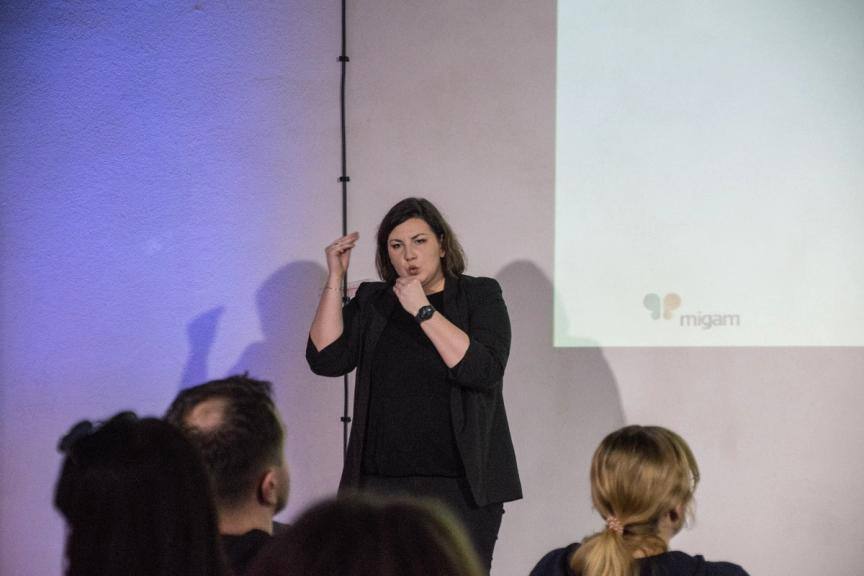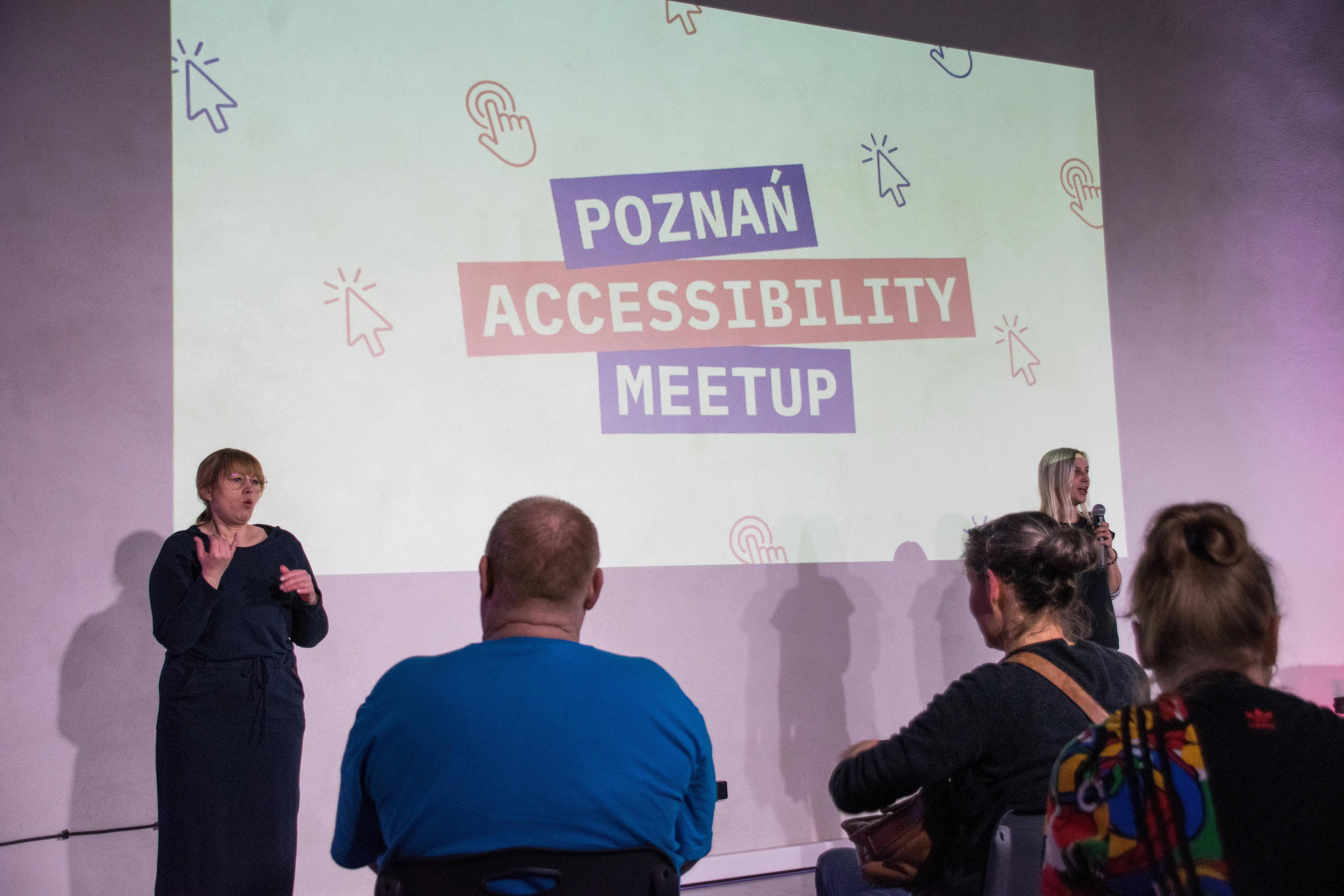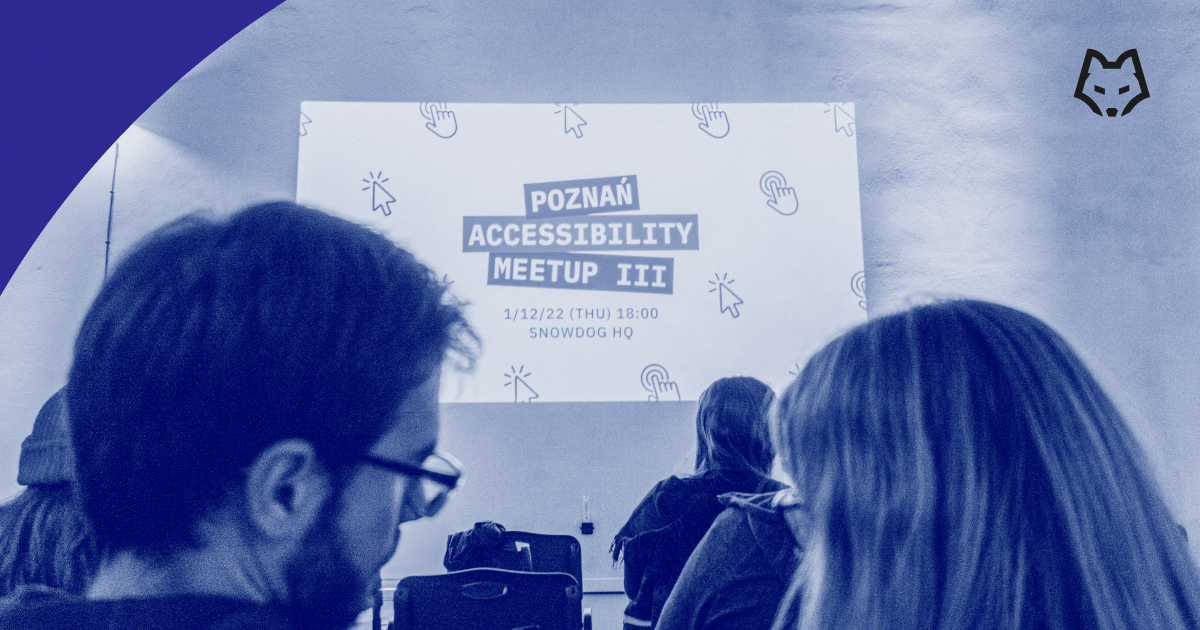On February 23, we met at the Snowdog HQ for the fourth accessibility event. The topic of this meeting? Deaf people. The event featured two speakers and two PJM translators who translated both the lectures and the questions asked by the attendees. What did we really learn during this event?

The first speech — PhD Beata Iwanicka
The first speech was delivered by PhD Beata Iwanicka, a deaf person from a medical point of view, but functionally hearing, who discussed the difficulties that deaf people living in Poland face, including language issues. She began her speech by explaining and debunking several myths that exist in society about deaf and hard-of-hearing people.
Myths about Deaf people
There are numerous myths about the deaf community. The most common ones include:
- All d/Deaf people know Polish Sign Language, but this is not true — some do not know any sign language, and some communicate using the Sign Language System.
- All d/Deaf people speak the same language. Just like with spoken language, every country in the world has its own sign language, so there is no universal sign language.
- All d/Deaf people read lips. This is a very difficult skill to learn, and most people who are hard of hearing or have lost their hearing later in life possess it.
- All d/Deaf people use the Polish language, and know its logic, spelling rules, etc. — this is not true.
- All d/Deaf people use a hearing aid/implant
- Hearing aid/implant fully restores hearing — Another myth. Each hearing aid is different, and how much it helps to hear depends on the technology and the degree of hearing loss in the individual. It is a very individual matter. As an example, Beata Iwanicka mentioned that without a hearing aid, she was not aware that her stomach rumbling could be heard in the lecture hall, or that doing laundry at 2 in the morning was not the best idea.
Is there such a thing as Deaf culture?
Yes, this social group can certainly be distinguished, and as such has its own culture. Deaf culture is a term referring to a social movement whose hallmark is the experience of deafness in the context of culture, but according to this term, deafness is not perceived as a disability.
Deaf people should be distinguished from deaf people. Deaf, written with a capital letter, refers to a person who is a member of the Deaf culture. It can be a hearing person, for example, the child of a Deaf person, or the partner, husband, or wife of a deaf person.
The essential element of this culture is sign language, in Poland, it is PJM, but every country has its equivalent, e.g., in the USA, it is ASL. Shared experiences, such as attending schools for the deaf or struggling with problems in the hearing world, contribute to the distinctiveness of this culture from the culture of the country in which these people live.
Audism — discrimination against the Deaf
Audism is a term used to describe discrimination or stereotypes about Deaf people. A person with audist attitudes assumes that hearing culture is better and more desirable than Deaf culture.
This topic was addressed by Iwanicka and compared to racism, where hearing people consider themselves superior to Deaf people. This is a harmful view that can be addressed in two ways. The first is through education, awareness-raising, and teaching of society. The second is through refusal to discriminate against Deaf people in relation to hearing people.
How can we support Deaf people? And why is communication so important?
Methods of supporting Deaf people include Oral-Aural-Single Sensory Methods, and Total Communication, but the most important is Polish Sign Language. It allows for free communication not only between Deaf and hearing people but also between hearing people and Deaf people.
Why is communication so important? Why should we promote the learning of Polish Sign Language? Because communication equals education.— Beata Iwanicka.

Can culture be… Deaf?
Most of us are familiar with movies such as Star Wars and The Matrix. Deaf people watch them too. The problem arises when it comes to classic Polish cinema, such as the movie “Dzień Świra”, which Deaf people cannot watch because it does not have subtitles in Polish.
Deaf people can only go to the cinema to watch movies with subtitles, but they have little chance of attending cultural events such as theatre, opera, concerts, exhibitions, and others. These events are not accessible to them. Even television in Poland often does not have subtitles in Polish Sign Language (PJM). According to statistics collected by the KRRiT, the percentage of broadcasts on Polish TV that have subtitles or PJM translation is very low.
This is precisely the negative aspect of the separate culture of Deaf people, but there is also a positive aspect. The development and popularization of PJM and other art forms such as pantomime, poetry, or music created specifically for Deaf people or including sign language, for example in music videos or at music festivals.
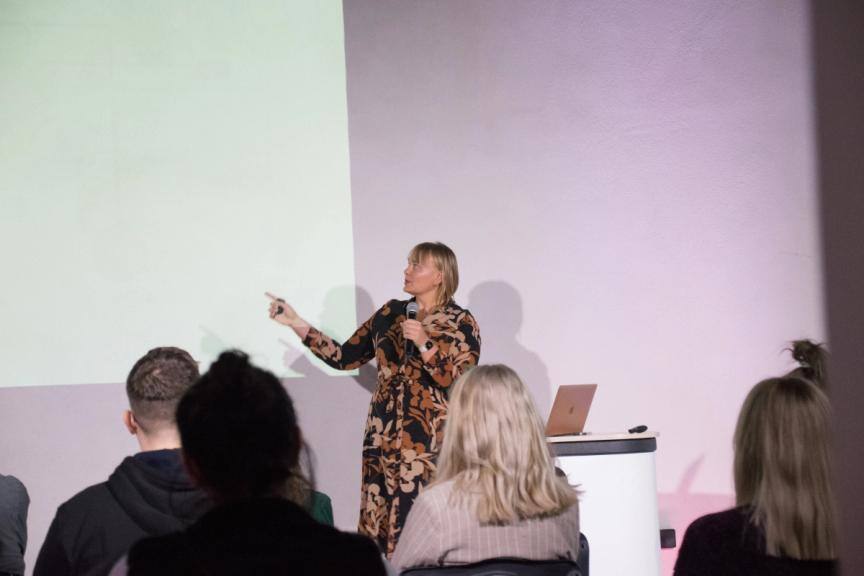
Assistive technologies and devices for the Deaf
Assistive devices include hearing aids and implants, FM systems and induction loops, and vibrating suits. Smartphones and smartwatches are also an important aid for deaf individuals.
Since I got my smartwatch, I haven’t been late for morning classes. Before, I was regularly late, which of course was taken advantage of by students, as the fifteen-minute rule applies. When I finally arrived at the university, there was usually no one in the classroom — Beata Iwanicka.
The Polish government offers subsidies for hearing aids. However, it should be noted that the prices of hearing aids vary depending on the degree of hearing loss, ranging from several thousand to even 8,500–9,000 PLN. It should also be noted that subsidies for FM systems may decrease or disappear after the age of 26.
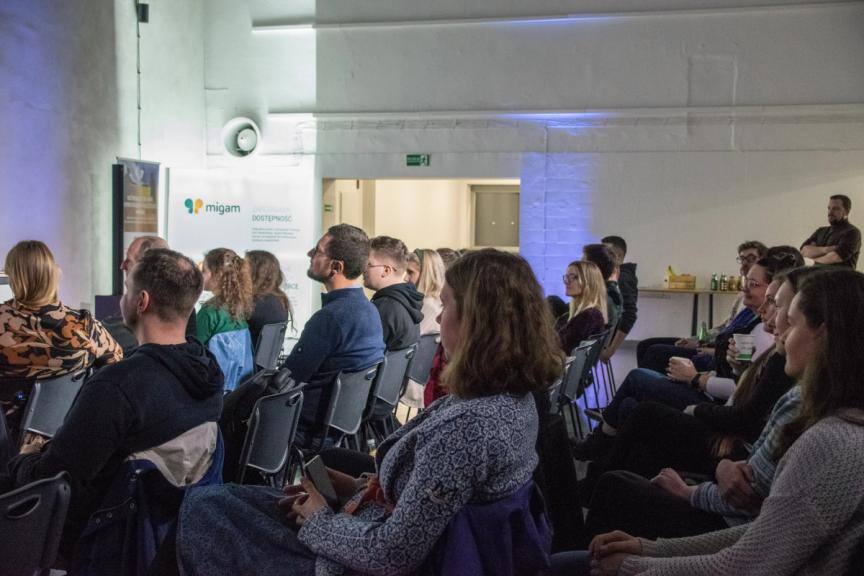
Digital Accessibility for the Deaf
In general, we are talking about three main elements of accessibility:
- Captions — refer to the written text that appears on the screen to provide a written representation of spoken dialogue and other relevant audio elements. This is important for deaf individuals who rely on visual cues to understand and follow along with video content.
- PJM interpreters — (Polish Sign Language) interpreters are trained professionals who translate spoken language into sign language, making it accessible for the deaf community. Incorporating PJM interpreters into events or video content ensures that deaf individuals can fully participate and understand the content.
- Audio description — refer to the verbal narration of visual elements within a video or other visual media. This is important for those who are visually impaired and rely on audio cues to understand what is happening on screen.
These three aspects are the most important elements of digital accessibility, which content creators, application developers, and website owners should strive to incorporate. It is worth including at least one of these elements in every project we create.
Second Lecture — Paweł Potakowski
Paweł Potakowski began his presentation “Enough of being deaf for the needs of the Deaf!” with several important facts and figures. There are 72 million Deaf people in the world who communicate using the sign language that is recognized in their respective countries. In Poland, there are 1 million people who are deaf, and 400,000 culturally Deaf people. This is a significant number, equivalent to the population of a big city such as Szczecin.
What are the main problems facing the deaf population?
The biggest problem is the lack of ability to communicate independently without an interpreter in everyday life, such as at the doctor’s office, government offices, or stores. We must remember that for Deaf Poles, the Polish language is like a foreign language, they do not understand it. A simple solution using the latest technology is online access to professional PJM interpreters.
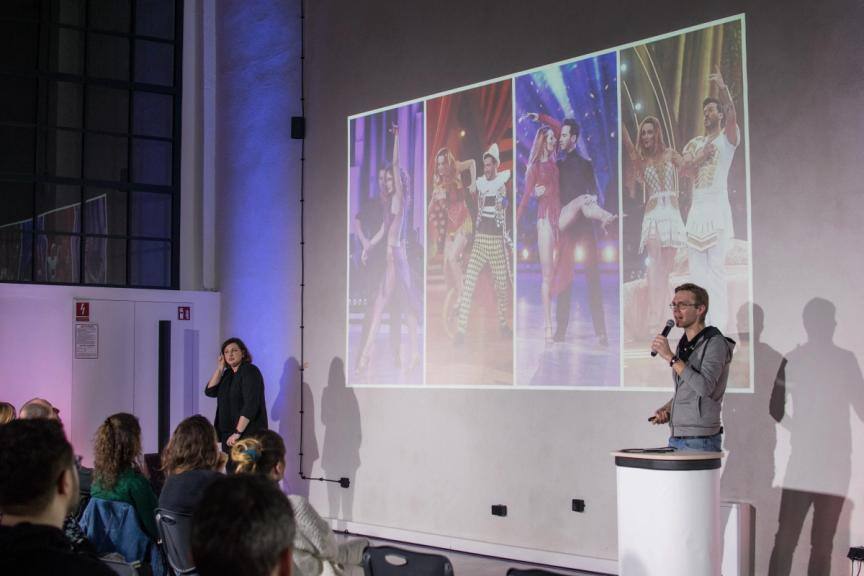
A few facts about the Deaf
- The word “Głuchy” (deaf) is not a pejorative term, contrary to what most people think.
- “Głuchoniemy” (deaf and mute) refers to a narrow group of people who cannot hear and are mute. Referring to deaf people as “głuchoniemy” is inappropriate.
- Deaf people cannot hear anything. A large part of the deaf population can hear or sense vibrations. They may hear sounds to some extent, but that does not mean they can understand hearing people.
- Not all deaf people can read lips.
- Deaf people are NOT less intelligent than hearing people. Communication problems arise from a language barrier, not a lack of intelligence.
- Deaf people have difficulty understanding written content in the Polish language. Their language — Polish Sign Language (PJM) — differs in logic, syntax, and grammar from the Polish language.
- PJM is not the same as SJM (Signed Polish).
Migam.org
Migam is a company where Paweł works. It is a company with a positive impact on the Deaf community. Their clients are companies and institutions, and their target audience is Deaf individuals. Since the beginning of their activity, they have translated around 300,000 conversations and over 5,000 films and documents. Migam is co-created by Deaf individuals, experts in sign language, and CODAs (Children of Deaf Adults).
Migam introduced a service for translations using a computer, tablet, or phone. The only thing that a Deaf or hearing person who wants to communicate with a Deaf person needs are headphones, a microphone, a camera, and the Internet. Migam makes the call on behalf of the Deaf person, and the sign language interpreter conveys the information to the recipient.

Last part — PJM Translators Eunika Lech, Joanna Mitschke-Mazur
The last part of the meeting was a short course of Polski Język Migowy — Polish Sign Language performed by the two translators present at the event — Eunika Lech and Joanna Mitschke-Mazur. They wanted to show us some not-very-obvious signs that could help us to communicate with Deaf people.

Very often people who use public transportation get hit with backpacks and bags while commuting — Deaf people occur in the same problem, but they cannot say anything and react properly. The translators showed us how to sign “I’m sorry”.
Later on, the audience chose words that mean animals just to demonstrate that sign language is very expressive — you do not only speak with your hands but with your whole body.
